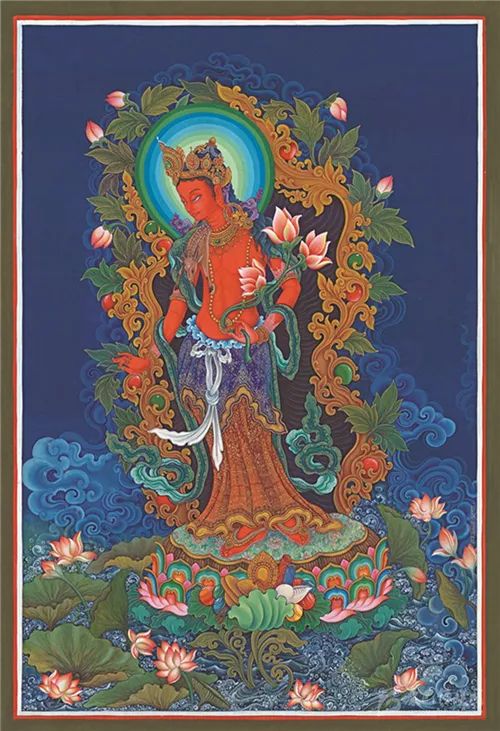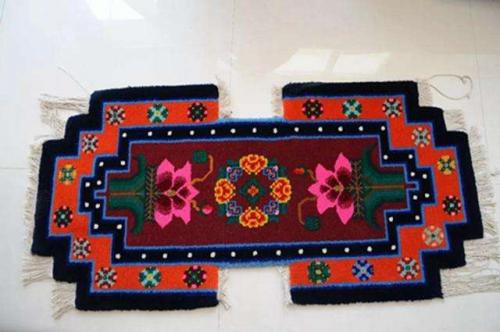藏地画谈||杨云:刻在藏地上的经书——玛尼石
编辑:青唐小将军
时间:2021-06-14 09:29:51
来源:西北特产网

(图左) 画家:杨云 (图右)刻经人
(Left) Painter: Yang Yun (Right) Engraver
走进藏区,神奇的玛尼石处处可见。
Walking into the Tibetan area, the magical Mani stone can be seen everywhere.
在雪域高原上的草地、湖畔、山口、寺院、玛尼石已成为藏区佛教精神物化的征物。千百年来融入人们的生活......
The grasslands, lakesides, mountain passes, monasteries, and Mani stones on the snow-covered plateau have become the relics of Buddhist spiritual materialization in Tibetan areas. Integrating into peoples lives for thousands of years...
在普通的石面上,刻经人以坚韧的意志,凭一把简单的榔头和几根錾子,雕打出绵长的经书、精致的佛像,神秘的六字真言,用朴实的情感赋予冰凉的石头以灵性,把对佛陀的虔诚与崇敬永久地镌刻在石头上。在浩莽的高原上留下了无数的玛尼石堆、石墙、石城等奇观。成为藏民族文化艺术中的瑰宝。
On the ordinary stone surface, the people carved the scriptures with a tenacious will, with a simple hammer and a few chisels, they carve out long scriptures, exquisite Buddha statues, and the mysterious six-syllable mantra, giving the cold stone spirituality with simple emotions, and permanently engrave the devotion and reverence to the Buddha on the stone. Countless mani stone piles, stone walls, stone cities, and other wonders were left on the vast plateau, which became a gem of Tibetan culture and art.

玛尼石也称“马智石”,“玛尼”二字是六至字真言:奄、嘛、呢、叭、咪、哞的简称。由玛尼石垒成的玛尼堆,藏语为“朵帮”。其堆顶可安放牛、羊角、牦牛头,或插上风马旗,拉上经幡,哈达供人礼拜。过往的藏民都会向石堆添石,石不分大小,也无需是否雕刻,积石成堆,并顺时针绕圈膜拜,在六字真言的吟诵中,把心底的祈福寄于玛尼石堆以获得佛的护佑和加持。
Mani stone is also called "Ma Zhishi", and the word "Mani" is the abbreviation of the six-syllable mantra: Om mani padme hum. The Mani pile made up of Mani stones is called "Duo Bang" in Tibetan. The top of the pile can be placed with cows, horns, and yak heads, or wind horse flags can be inserted, and prayer flags can be pulled up to have Hada for worship. Tibetans would add stones to the stone piles when they pass there. The stones can be large or small and do not need to be carved. The piles of stones are piled up and worshiped in a clockwise circle. In the recitation of the six-syllable mantra, people send the blessings from the bottom of the heart to the mani stone pile to obtain the protection and blessing of the Buddha

藏民敬石,由来已久。印度佛教文明尚未进入西藏前,藏民的先民们奉行原始的雍仲本教。高原气候变幻莫测,在严酷的自然生存环境下,人显得极为渺小。由此人们对山川、湖泊充满迷惘和敬畏,视山为神,敬为“神山”。世世代代绕山朝拜。从最初的敬山崇石到融于生活的漫长历史中,藏民们筑石造房,供石镇宅,配石添美,垒石堆而礼拜,世代传衍。使藏民族成为世界上与石最为亲密,对石最为崇敬的民族之一。
Tibetans respect stone for a long time. Before the Indian Buddhist civilization entered Tibet, the ancestors of Tibetans practiced the primitive Bon religion. The climate on the plateau is unpredictable, and people appear extremely small in the harsh natural living environment. As a result, people are perplexed and awed by mountains and lakes, and they view mountains as gods and respect them as "sacred mountains". They worship around the mountain for generations. From the initial worship of mountains and stones to the long history of being integrated into life, Tibetans built houses with stones, provided stone houses for towns, added stones to add beauty, built stones and worshiped, and passed on from generation to generation. Making the Tibetan people one of the most intimate and respectful of Stone in the world.

现存青海南部玉树的新寨“玛尼石经城”,从公元1715年起至今的几百年里,朝拜的藏民们一块块垒加的玛尼石数量已达二十五亿块之多,这座经城东西长283米,南北宽74米,高2.5米,占地多达二十五亩,其宏大的体量,巍峨的气势,彰显的信仰之力令人震憾!
The existing "Mani Stone Scripture City" in Xinzhai, Yushu, southern Qinghai has accumulated over 2.5 billion mani stones from the worshipping Tibetans from 1715 to today. This scripture city is 283 meters long from east to west, 74 meters wide from north to south, 2.5 meters high and covers an area of 25 acres. Its magnificent volume, majestic momentum, and the power of faith are shocking!

被誉为“世界第一石书”的青海泽库和日寺山顶的“和日经墙",全用刻有佛教大藏经著名的《甘珠尔》和《丹珠尔》等经文的青石板堆叠而成,耗石材数十万片,历时150多年,实属举世奇观。记得一次在拉萨布达拉宫广场边药王山下的一个山洞,一位中年刻经人专注地雕打着玛尼石。在不大的山洞里,沿洞壁摆满了他刻打的作品:经书、图案、佛像、六字真言,一并聚全。雕刻技法自然朴拙,线描素雕、高低浮雕、阴刻阳刻,彩色配刻,丰富精美。我们一阵交谈,得知就在他身后的药王山南侧的陡壁,公元七世纪藏王松赞干布命尼泊尔工匠在摩岩上刻像,至今,岩壁已刻有五千多尊佛像。
Zeku, Qinghai, which is known as "the worlds first stone book" has a wall on a mountain piled with blue stones that are craved with the famous "Ganggyur", "Tengyur" and other scriptures in the Buddhist Tripitaka. It used hundreds of thousands of stones, took more than 150 years to build, which is impressive throughout the world. I remember once in a cave at the foot of Yaowang Mountain on the side of the Potala Palace Square in Lhasa, a middle-aged engraver carves the Mani stone intently. In a small cave, the walls of the cave are filled with his carved works: scriptures, patterns, Buddha statues, and six-syllable mantra, all gathered together. The carving technique is natural and simple, with rich use of color, each of them is ample and exquisite on the surface. We talked for a while and learned that the steep wall on the south side of Yaowang Mountain was behind him. In the 7th century AD, the Tibetan king Songtsen Gampo ordered Nepalese craftsmen to carve images on Moyan. So far, more than 5,000 Buddha statues have been carved on the rock wall.
刻经人形象极好,古铜色肤色的脸上佩戴一副眼镜,增添几分文艺气。我欣然为他画了张肖像,并请他在这件作品上了留下了姓名。
The appearance of the engraved person is very good, the bronze-colored face wears a pair of glasses, adding a bit of literary and artistic atmosphere. I gladly painted a portrait of him and asked him to leave his name on this work.

我天性崇尚原始的朴拙之美,早年从西安就捎回来几件半坡原始遗址的土陶和汉唐的陶俑复制品置于案头。次后,又从川藏阿坝和西藏萨迦请回了两尊玛尼石经文和佛像。新近的迁居,老师敬廷尧先生赠我一尊珍贵的绿度母佛像玛尼石,成为我的珍爱之物,供于宅中祈福吉祥,时时勾起我对藏地的念想......
I naturally admire the beauty of primitive simplicity. I brought back a few clay pots from the original Banpo ruins and replicas of pottery figurines of the Han and Tang Dynasties from Xian in the early years and placed them on my desk. After that, I brought back two Mani stone scriptures and Buddha statues from Aba in Sichuan and Sakya in Tibet. Recently, my teacher, Mr. Jing Tingyao, gave me a precious green Tara Buddha Mani stone, which became my cherished object and used it in my house to pray for blessings and auspiciousness. It always reminds me of Tibet...
杨云作品 Yang Yuns Works






整理/ Organize:Lisa
编译/Celine & Louis
审核/ Cindy & Mary
制作/ Produce:AIPU
阅读:
工艺特产特点
纯手工工艺特产







